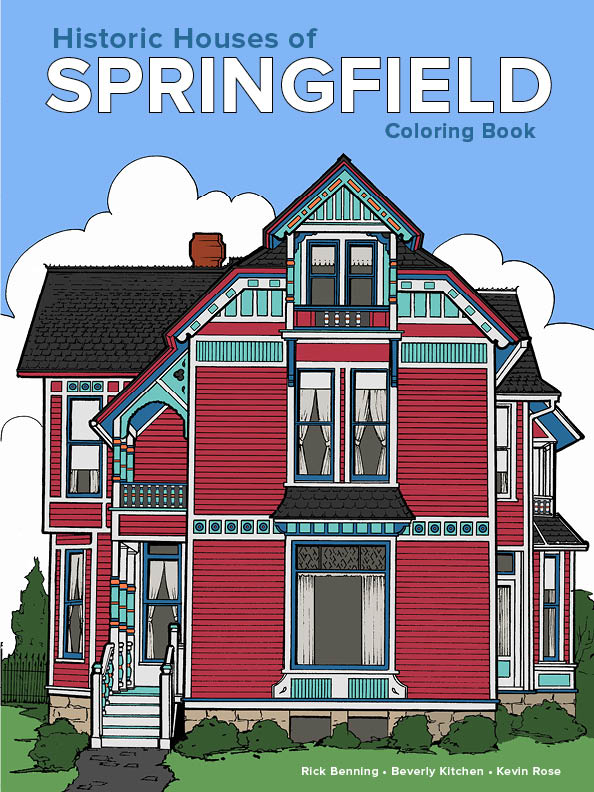Coloring Springfield
The idea of developing a coloring book of Springfield houses began back in 2006. After discovering that a house nearly identical to Laurie Stanton’s South Fountain home graced the cover of Dover’s Victorian Houses coloring book, we decided that Springfield needed a book of its own. The first step was obviously finding the money to kickoff the project. As I worked for the Turner Foundation, I encouraged our team to apply for one of Turner’s highly-competitive grants that fall. This of course required a budget, which in return caused us to find an artist to complete the work. Rick Benning, our first choice, thankfully agreed to the project and gave us a fair price for creating the art. I could handle the editing and design in my free time, which meant that the only other significant cost was printing. After quoting three area printers, we selected Westendorf Printing. The grant was submitted that fall and we received word later that year that we were successful. So, at the start of 2007, we were ready to officially start the project.
What is now Westcott’s Education Committee spearheaded the project. Although the original idea was to select only houses along South Fountain Avenue and East High Street, our two historic districts, the committee wanted more diversity in the types of houses included. However, the decision was made to stay focused on houses from around the end of the Civil War to the beginning of First World War, and to include mostly houses from the two districts. I identified approximately forty houses in and around Springfield, which the committee whittled down to twenty. It was a difficult, but enjoyable, task. Although “landmark” houses like Bushnell House and Westcott House were selected, the committee also wanted to feature on less prominent houses. In some cases, this favored houses like the Rinehart House (815 East High Street) over the very similar Foos Manor (810 East High Street), while in other cases in favored houses that are off the beaten path like the Smith House (518 West High Street), Arbogast House (325 South Yellow Springs Street), and Bauer House (1583 Lagonda Avenue). While I did not include my personal residence in the original list of forty, due to what I considered a conflict of interest, I admit that I was thrilled when Ken Shook pushed the other committee members to include it.
After the twenty houses were selected, I set about completing detailed research and developing short write-ups for each house. We also started taking high-quality photographs for the use of the artist. To get the angle that we desired, Rick lent us his twelve-foot step ladder, which hung out of the back of my pickup truck as we darted across town. After the images were edited and put onto a disk, Rick set about creating the art. To assist him with the task, he recruited his colleague and mentor Bev Kitchen to the project. In the fall of 2008, Rick and Bev delivered twenty finely executed drawings, each sized 18”x24”. I will admit that we were not expecting them to be that large, although this greatly enhanced the clarity of each image. The trouble was finding a scanner that could accommodate the oversized originals. After checking with local architects, our friends at Eagle Tool agreed to scan the images for free in their engineering department. I immediately set about editing the images, which required approximately three hours per image, and designing the book. By the end of 2009, the book was nearly complete! Then it sat on my computer, nearly finished, for seven years. The delay started with the coloring of the cover. This was much more difficult than we had expected. The original idea was to hand color one of the images – the Scott House on South Fountain Avenue was selected due to its imaginative color scheme – but this produced less than spectacular results. We even worked with students at Springfield High School to test techniques and styles, but in the end, we had to go back to the drawing board (or perhaps the coloring board). We decided that a digitally colored image would achieve the desired look, although this process required copious houses of editing. As I did not have time for the editing, the project was pushed onto the back burner.
After years of being teased by my committee members about the project not being completed, I revisited the project in fall of 2014. I set aside the time in my schedule to edit and color the cover image, revise the histories, and complete all of the missing details. We were aiming for Fall 2015 printing, just in time for the holiday shopping season. Once again, last minute changes and delays at the printer caused us to rethink our plans. Instead, we decided to aim for a spring release. The help us celebrate the conclusion of a project nearing ten years in the making (or waiting), we organized a coloring contest for all age. You can download a form here. Suzy Turner and a team of volunteers spearheaded a launch party in the gardens of the Westcott House, which was an elegant (and colorful) event. After ten years, we were finally able to share the book with our members and friends. I believe that it was worth the wait!

Coloring Book Cover
It is difficult to thank everyone who worked on this project since its inception. So many people contributed their talents along the way, including Richele Shepard, Laurie Stanton, Rick Benning, Beverly Kitchen, Marta Wojcik, Andy Hayes, Bill Brougher, Deanna Brougher, Ken Shook, Phyllis Hill, Barbara Walker, Pam George, Suzy Turner, Robin Inboden, Gretchen Krafft, Ski Schanher, Kathleen Day, Cindy Catazaro, Alan Ladd, Ruby Daily, John Blazer, and Tom Fyffe. In addition, none this would have been possible without a generous grant from the Turner Foundation, and later support from Ohio Humanities.